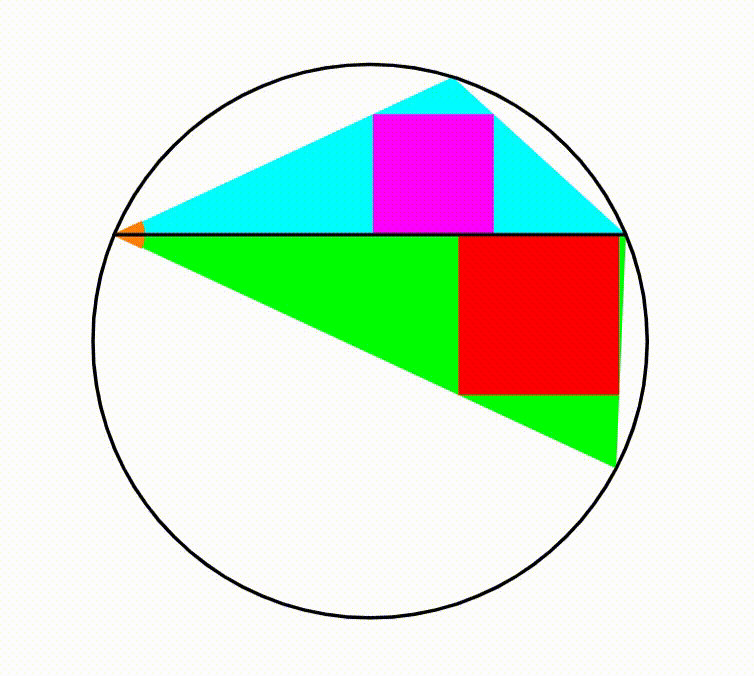Dynamic Geometry: P112
 The diagram shows a black circle. A horizontal black chord is drawn creating two circular segments, their respective heights are
and
. In each circular segment, we inscribe a triangle. In both triangles we inscribe a square. The triangles are both evolving so that the two orange angles are always equal. When the ratio of upper square's area to the lower square's area is equal to
, the distance between the two moving points of both triangles is an integer, what is this integer?
The diagram shows a black circle. A horizontal black chord is drawn creating two circular segments, their respective heights are
and
. In each circular segment, we inscribe a triangle. In both triangles we inscribe a square. The triangles are both evolving so that the two orange angles are always equal. When the ratio of upper square's area to the lower square's area is equal to
, the distance between the two moving points of both triangles is an integer, what is this integer?
The answer is 12.
This section requires Javascript.
You are seeing this because something didn't load right. We suggest you, (a) try
refreshing the page, (b) enabling javascript if it is disabled on your browser and,
finally, (c)
loading the
non-javascript version of this page
. We're sorry about the hassle.
Let the dividing chord of the circle be A B , the upper and lower variable triangles be △ A B C and △ A B C ′ respectively, and the measure of the orange angle be θ . Referring the calculations in Dynamic Geometry: P96 Series , the radius of the circle is 6 . 5 , A B = 1 2 , ∠ A C B = π − tan − 1 5 1 2 , and ∠ A C ′ B = tan − 1 5 1 2 .
Now let us consider the relationship between the side length s of a square K L M N to the height C D = h and width A B = w of the triangle △ A B C that inscribes it. Note that △ K L C and △ A B C are similar. Let the height of △ K L C be C E , then C E = w s h . From C D = C E + E D , we have
h = w s h + s ⟹ s = 1 + w h h = h + w w h = h + 1 2 1 2 h Since w = A B = 1 2
Similarly for the square in △ A B C ′ , s ′ = h ′ + 1 2 1 2 h ′ .
Since A C B C ′ is a cyclic quadrilateral , ∠ B C C ′ = ∠ B A C ′ = θ and ∠ B C ′ C = ∠ B A C = θ . Therefore △ B C C ′ is isosceles and B C = B C ′ = b . By sine rule ,
sin ∠ C A B B C = sin ∠ A C B A B ⟹ b = sin ( π − tan − 1 5 1 2 ) 1 2 sin θ = sin ( tan − 1 5 1 2 ) 1 2 sin θ = 1 3 sin θ
Then { h = b sin ∠ C B A = b sin ( tan − 1 5 1 2 − θ ) h ′ = b sin ∠ C ′ B A = b sin ( tan − 1 5 1 2 + θ ) = sin θ ( 1 2 cos θ − 5 sin θ ) = sin θ ( 1 2 cos θ + 5 sin θ )
The ratio of areas of the square s ′ 2 s 2 = 2 1 1 6 9 6 1 ⟹ s ′ s = 1 2 h ′ ( h + 1 2 ) 1 2 h ( h ′ + 1 2 ) = h ′ ( h + 1 2 ) h ( h ′ + 1 2 ) = 4 6 3 1 . Therefore,
( 1 2 cos θ + 5 sin θ ) ( sin θ ( 1 2 cos θ − 5 sin θ ) + 1 2 ) ( 1 2 cos θ − 5 sin θ ) ( sin θ ( 1 2 cos θ + 5 sin θ ) + 1 2 ) sin θ ( 1 4 4 cos 2 θ − 2 5 sin 2 θ ) + 1 4 4 cos θ − 3 0 8 sin θ 1 6 9 sin θ cos 2 θ + 1 4 4 cos θ − 3 3 3 sin θ 1 6 9 cos 2 θ + 1 4 4 cot θ − 3 3 3 1 + t 2 1 6 9 + t 1 4 4 − 3 3 3 ( 3 t − 2 ) ( 1 1 1 t 2 + 2 6 t + 7 2 ) ⟹ t = 4 6 3 1 = 0 = 0 = 0 = 0 = 0 = tan θ = 3 2 Let t = tan θ For real value of t
Then the distance between the two moving points C C ′ = 2 b cos θ = 2 6 sin θ cos θ = 2 6 ⋅ 1 3 2 ⋅ 1 3 3 = 1 2 .